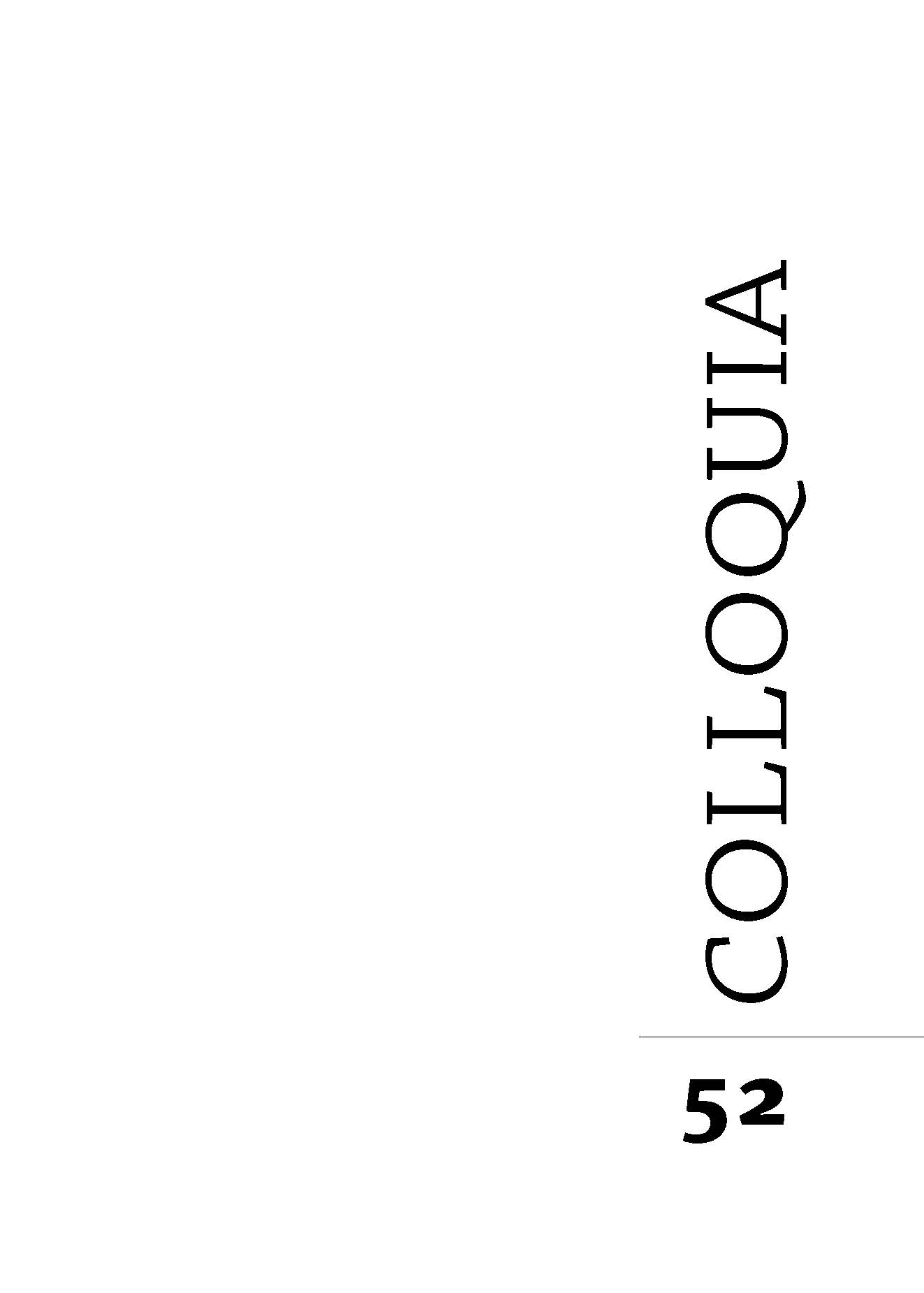Pratarmė
Santrauka
52-asis Colloquia numeris skaitytojams siūlo itin platų temų ir rubrikų spektrą. Mokslinių straipsnių publikacijos pradedamos reikšmingu, naują archyvinę medžiagą pristatančiu Brigitos Daugėlaitės tyrimu, skirtu Kazio Borutos sekimui sovietmečiu. Valstybės saugumo struktūros rašytoją stebėjo ir sekė iki pat mirties, todėl remdamasi Lietuvos ypatingajame archyve esančia dviejų tomų (447 ir 511 lapų) Borutos operatyvinio stebėjimo byla, Daugėlaitė detaliai atskleidžia, kaip ir kodėl Boruta buvo sekamas, kokią įtaką tai darė jo asmeniniam ir kūrybiniam gyvenimui. Manfredo Žvirgždo tyrimas susijęs su neseniai publikuotu 1938–1945 m. rašytu Vinco Mykolaičio-Putino dienoraščiu ir jame iškylančiu Vilniaus vaizdiniu. Sostinės išvadavimą 1939 m. rašytojas itin džiaugsmingai sutiko, o vėlesniais 1940–1944 m. rūpinosi lietuvių kultūros ir mokslo pozicijų mieste stiprinimu, dažnai balansuodamas tarp kultūrinės rezistencijos ir prisitaikymo. Netikėtu kūrinių gretinimu paremtas Gintarės Bernotienės straipsnis: išmone grįstą W. G. Sebaldo romaną Austerlicas ji gretina su lietuvių tremtinių atsiminimais ir tyrinėja, kaip skirtingai jų pasakojimuose kraštovaizdis ir architektūra perteikia traumas išgyvenusių subjektų atminties procesus ir komplikuotą santykį su vieta. Romane fiksuotą praeities nesugrąžinamumą įvaizdinanti bedugnės metafora tremtinių atsiminimuose atsikartoja kaip socialinės prarajos vaizdinys.
Jurgita Žana Raškevičiūtė detaliai pasakoja apie Juozo Tumo-Vaižganto autobiografinių Aukštaičių vaizdelių formavimo, bandymo publikuoti ir išardymo istoriją. Apibendrindama atliktą tyrimą mokslininkė daro prielaidą, kad Tumas, rašydamas Aukštaičių vaizdelius, kūrė ne kūrėjo, literato ar kunigo, bet regioninę asmens autobiografiją. Mokslinių straipsnių publikacijas baigia feministinės kritikos prieiga grindžiami Agnės Cesiulės ir Ievos Šakelaitės straipsniai. Cesiulė praveria netyrinėtą nepriklausomos Lietuvos kūrėjų-moterų gyvenimo plotmę: kūrybinius vakarus, vykusius 1930–1938 m., ryškindama literatūroje dalyvavusių moterų būtinybę solidarizuotis siekiant bendro tikslo – įtvirtinti moters kaip rašytojos statusą. Šakelaitė jau iš šių dienų perspektyvos aptaria Poezijos pavasario metu vykstančius poečių skaitymus prie Žemaitės paminklo Vilniuje, skaitymus, kaip ir Cesiulės nagrinėjamu atveju, matydama kaip kūrėjas vienijantį veiksmą ir kaip galimybę užklausti esamus galios santykius.
Šio numerio publikacijų skiltyje – įdomus Giedrės Šmitienės pasakojimas apie Janinos Degutytės ir Bronės Jacevičiūtės-Jėčiūtės draugystę, paremtas išlikusiais Jacevičiūtės-Jėčiūtės laiškais ir ryškinantis tarptekstinius sąryšius su to laiko Degutytės eilėraščiais ir Jacevičiutės-Jėčiūtės tapybos darbais.
Diskusijų skiltyje skelbiamas pokalbis apie Vytautui Kubiliui itin rūpėjusią demokratinės, sąmoningos, kritiškai mąstančios visuomenės idėją, išsakytą ir gana gausioje jo su Lietuvos nepriklausomybės atkūrimu susijusioje publicistikoje. Susitikti pokalbiui, kuriame dalyvavo žinomi politikai, istorikai, literatūros mokslininkai, paskatino Martyno Mažvydo nacionalinės bibliotekos parengta ir išleista bibliografinė rodyklė Vytautas Kubilius. Bibliografinis darbų sąrašas 1988–2004. Pokalbį apie Vytauto Kubiliaus įsipareigojimą visuomenei pratęsia šių metų Vytauto Kubiliaus premijos laureatės Neringos Butnoriūtės kalba, akcentuojanti kritikų pastangas išlaikyti kritinio kalbėjimo pulsą, kuri skelbiama skiltyje Nuomonių domino.
Vis nesibaigiančiame bendrojo lavinimo mokyklų lietuvių kalbos ir literatūros programų kaitos kontekste itin aktuliai nuskamba mokslininkės, literatūros didaktės Reginos Kuzmaitės-Norkevičienės mintys apie mokyklines programas, neišvengiamą laviravimą sovietmečiu ir privalomą mokyklinės specifikos išmanymą. Mokslininkę kalbina Saulius Vasiliauskas.
Recenzijų skiltyje Rita Tūtlytė recenzuoja neseniai pasirodžiusią Marijaus Šidlausko kritinių straipsnių rinktinę Kairiarankio kentauro pėdomis, ryškindama vertybinį knygos pagrindą ir autoriaus drąsą kalbėti vadovaujantis sąžine. Gitana Vanagaitė aptaria Dalios Kuizinienės parengtą išeivijos dailininko ir visuomenininko Vytauto Osvaldo Virkau 1944–1952 m. rašytą dienoraštį, o Aistė Lazauskienė – istoriko Mindaugo Balkaus monografiją Kaip Kovno tapo Kaunu: miesto lituanizavimas 1918–1940 m.

Šis kūrinys yra platinamas pagal Kūrybinių bendrijų Priskyrimas 4.0 tarptautinę licenciją.
Atsisiuntimai
Skaitomiausi šio autoriaus(ų) straipsniai
- Gitana Vanagaitė, Avangardinė „Keturių vėjų“ karo apokalipsė , Colloquia: T 54 (2024): Colloquia
- Gitana Vanagaitė, Santykis su emigracija Vinco Kudirkos ir Juozo Tumo-Vaižganto publicistikoje , Colloquia: T 50 (2022): Colloquia
- Gitana Vanagaitė, Redakcinė kolegija ir turinys , Colloquia: T 51 (2023): Colloquia
- Gitana Vanagaitė, Nurodymai autoriams ir bibliografiniai duomenys , Colloquia: T 51 (2023): Colloquia
- Gitana Vanagaitė, Pratarmė , Colloquia: T 51 (2023): Colloquia
- Gintarė Bernotienė, Karolina Bagdonė, Gitana Vanagaitė, Doktorantūra Lietuvoje - ,,be lūkesčių, gairių ir studijų politikos'' , Colloquia: T 47 (2021)
- Gitana Vanagaitė, Vaižgantas Lietuvos mokykloje , Colloquia: T 47 (2021)
- Gintarė Bernotienė, Gitana Vanagaitė, Apie literatūros ir gyvenimo būsenas. Pokalbis su Jūrate Sprindyte , Colloquia: T 50 (2022): Colloquia
- Gitana Vanagaitė, Vaižganto Dėdės ir dėdienės literatūros istorijoje, kine ir teatre , Colloquia: T 41 (2018)
- Gitana Vanagaitė, Tomas Vaiseta, Mindaugas Nastaravičius, Klausytojus užklausiantis kalbėjimas , Colloquia: T 50 (2022): Colloquia
